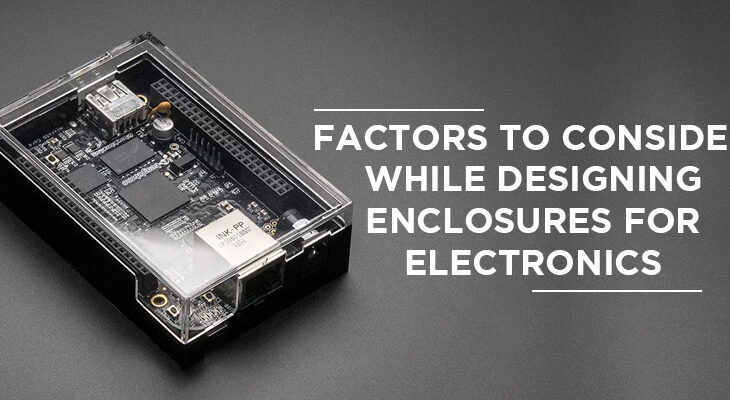
When designing an enclosure for electronics packaging, several factors should be considered are as follows,
Size and Form Factor:
The size and shape of the enclosure should accommodate the dimensions and configuration of the electronic components. It should provide sufficient space for mounting the circuit boards, connectors, and other necessary elements.
Material Selection:
The choice of materials for the enclosure is important. It should provide adequate protection against environmental factors such as moisture, dust, and electromagnetic interference. Common materials include plastics, metals, and composites.
Structural Integrity:
The enclosure should be structurally robust to protect the electronics from physical damage. It should be able to withstand vibrations, shocks, and potential impacts during handling, transportation, and operation.
Thermal Management:
Electronics generate heat, so the enclosure should facilitate proper thermal management. It should incorporate ventilation, heat sinks, or fans to dissipate heat and prevent overheating of components.
EMI/RFI Shielding:
To prevent electromagnetic interference (EMI) and radio frequency interference (RFI), the enclosure should include shielding materials or coatings. This helps to maintain signal integrity and prevent disturbances to nearby electronic devices.
Accessibility and Serviceability:
The design should allow for easy access to the internal components for maintenance, repairs, or upgrades. Considerations such as removable panels, connectors, and modular designs can simplify servicing.
Environmental Protection:
The enclosure should protect the electronics from environmental conditions such as moisture, humidity, dust, and chemicals. Sealing mechanisms, gaskets, and IP (Ingress Protection) ratings can ensure adequate protection.
User Interface and Ergonomics:
If the electronics require user interaction, the enclosure should accommodate buttons, displays, ports, and other user interface elements in a convenient and ergonomic manner.
Regulatory Compliance:
Depending on the application and target market, the enclosure design should comply with relevant regulatory standards and certifications, such as safety and electromagnetic compatibility (EMC) requirements.
Aesthetics and Branding:
The visual design of the enclosure can impact product perception and user experience. Consideration should be given to aesthetics, branding elements, and the overall product appearance.
Cost and Manufacturing Feasibility:
The chosen enclosure design should be cost-effective and manufacturable within the available production capabilities. Design complexity, material selection, tooling requirements, and assembly processes should be considered to ensure feasibility.
By considering these factors, you can design an enclosure that provides adequate protection, functionality, and usability for the electronics being packaged.

Benefits Of Using Plastic Enclosures:
Cost-Effective:
Plastic enclosures are generally more affordable compared to sheet metal enclosures. The manufacturing processes for plastic, such as injection molding, are often more cost-effective for high-volume production.
Design Flexibility:
Plastic is highly versatile and allows for intricate and complex designs. It can be easily molded into various shapes and sizes, enabling greater flexibility in accommodating different electronic components and configurations.
Lightweight:
Plastic enclosures are lighter in weight compared to sheet metal enclosures. This can be advantageous in applications where weight reduction is important, such as portable devices or equipment that needs to be mounted or carried.
Insulation and Electrical Safety:
Plastic is an insulating material, which provides electrical safety benefits. It helps to protect the electronics from electrical shocks and short circuits, reducing the risk of damage or harm.
Corrosion Resistance:
Unlike metals, plastics are generally resistant to corrosion. They can withstand exposure to moisture, humidity, and certain chemicals without degrading or rusting. This makes plastic enclosures suitable for outdoor or harsh environment applications.
Benefits Of Using Sheet Metal Enclosures:
Durability and Sturdiness:
Sheet metal enclosures are known for their robustness and durability. They provide superior mechanical strength and protection against impacts, vibrations, and rough handling. Sheet metal enclosures can withstand harsh conditions and offer long-term reliability.
EMI/RFI Shielding:
Metal enclosures inherently provide better electromagnetic interference (EMI) and radio frequency interference (RFI) shielding compared to plastic. Metal acts as a natural barrier to electromagnetic waves, helping to prevent interference and maintain signal integrity.
Heat Dissipation:
Metals have excellent thermal conductivity properties, allowing for efficient heat dissipation. Sheet metal enclosures can act as effective heat sinks, dissipating heat generated by electronic components and preventing overheating.
Improved Security:
Metal enclosures offer better security and tamper resistance compared to plastic. They are harder to break or manipulate, making them suitable for applications where protecting sensitive electronic equipment or data is crucial.
Mechanical Protection:
Sheet metal enclosures provide higher mechanical protection against physical damage, including impacts, punctures, and compression. This is particularly important in rugged or industrial environments where the electronics may be exposed to harsh conditions.
Easier EMI Compliance:
Metal enclosures can simplify electromagnetic compatibility (EMC) compliance as they naturally provide a shield against EMI/RFI. This can reduce the need for additional shielding measures or complex designs to meet regulatory requirements.
It’s important to note that the choice between plastic and sheet metal enclosures depends on the specific requirements of the electronics, including factors such as cost constraints, design complexity, environmental conditions, and the desired balance between electrical safety, durability, and shielding capabilities.
Electronics packaging is becoming more complex as year progresses. Products are becoming smaller and performance factors are going high. Ensuring a well-engineered packaging is very important for the product stability and success. Sunstream’s mechanical design services team is very well experienced in electronics enclosures for a wide variety of applications including, automotives, telecom, consumer, medical and industrial.
Our 3D Modeling Services, CAD drafting services, Analysis services and industrial engineering services has helped several customers to reduce their cost of development and time to market for new products.




 +1.585.935.7123
+1.585.935.7123 +91-804-148-6861
+91-804-148-6861